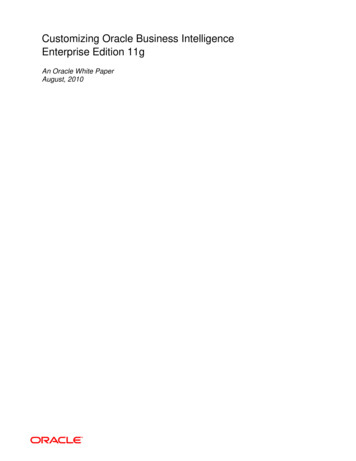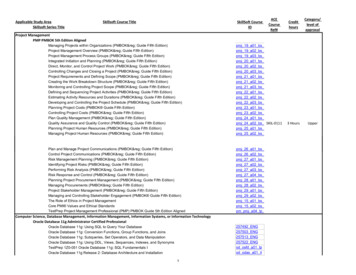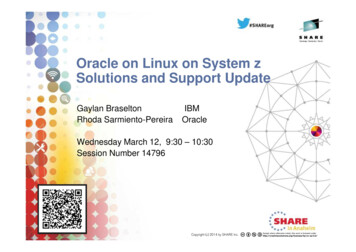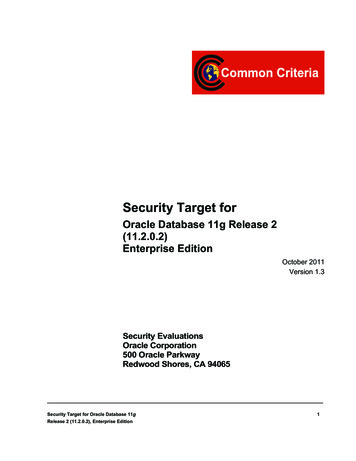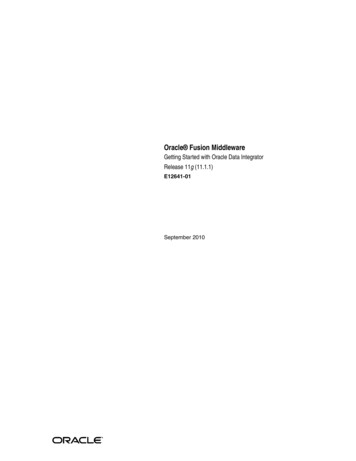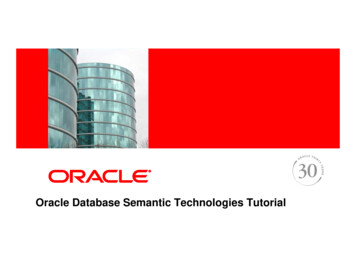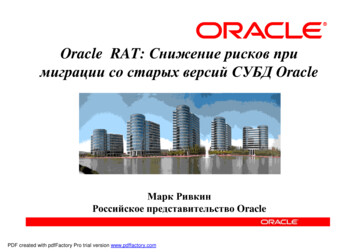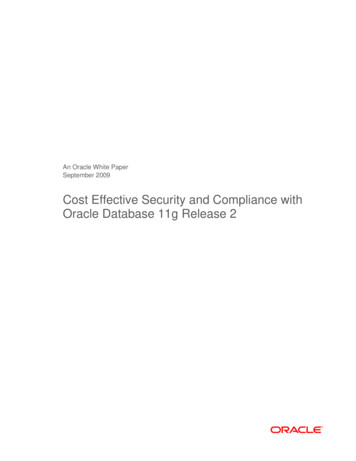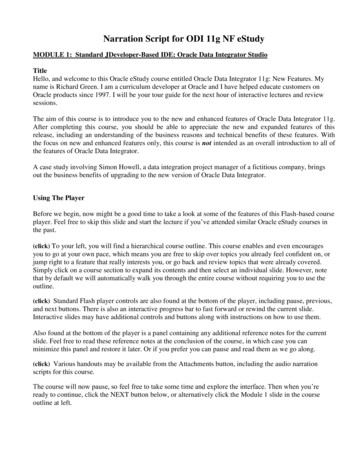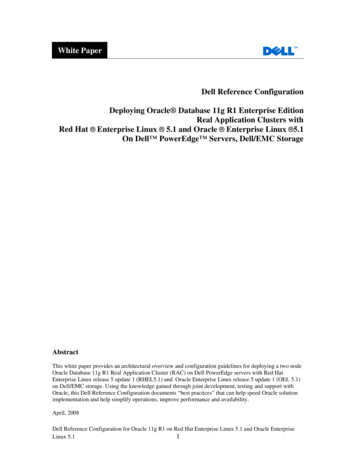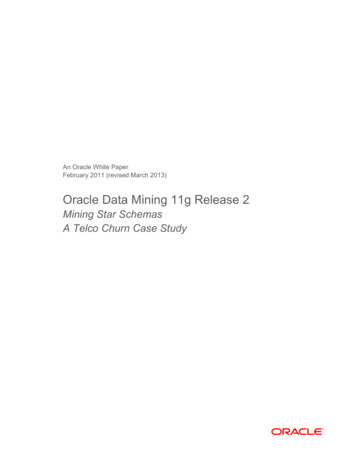
Transcription
An Oracle White PaperFebruary 2011 (revised March 2013)Oracle Data Mining 11g Release 2Mining Star SchemasA Telco Churn Case Study
Oracle White Paper— Oracle Data Mining 11g Release 2: Mining Star Schemas, A Telco Churn Case StudyTable of ContentsExecutive Overview . 2Section 1: Introduction . 3Section 2: Preparing the Schema . 4Section 3: Importing the Workflow . 6Section 4: Running the Workflow . 8Section 5: Understanding the Workflow . 10Section 6: Conclusions . 29Section 7: References . 30
Oracle White Paper— Oracle Data Mining 11g Release 2: Mining Star Schemas, A Telco Churn Case StudyExecutive OverviewOracle Data Mining (ODM) is a priced option to the Oracle Database 11gEnterprise Edition. Mining runs directly in the database, removing issues associatedwith data movement, data duplication, security, and scalability. Moreover, ODM hasbeen designed to fit well with the SQL language. While other data mining productsneed to utilize complex and non-performant operations when trying to mine data instar schemas – such as transposing from transactional form to a flat, relational form ODM is designed to leave the data in its natural form and mine it directly. Such anapproach yields simplicity, power, and improved performance.2
Oracle White Paper— Oracle Data Mining 11g Release 2: Mining Star Schemas, A Telco Churn Case StudySection 1: IntroductionA churn analysis case study [CACS] performed by Telecom Italia Lab presents a realworld solution for mining a star schema to identify customer churn in thetelecommunications industry. [CACS] provides some background on the churnproblem, and a detailed methodology describing the data processing steps requiredto predict churn. [CACS] is a natural fit for Oracle Data Mining and serves to showthe power and simplicity of using ODM to mine a star schema. This white paper isheavily based on [CACS], and though this white paper can be read stand-alone, it isrecommended that the reader become acquainted with the original case study.Steps for implementing the methodology using the Oracle Data Mining API,together with additional SQL, are available in a blog three-post series [AOB]. Thiswhite paper is intended for an audience that uses Oracle Data Miner, the graphicaluser interface for ODM, which is available from within SQL Developer 3.0.This white paper has two goals: Demonstrate a telco churn case study using Oracle Data Miner Explain the case study workflow methodologySections 2, 3, and 4 demonstrate the case study by preparing a database schema andimporting a pre-made Oracle Data Miner workflow. At the conclusion of Section 4,a fully functional implementation of the churn methodology is made available.Section 5 describes the workflow in detail, relating the operations performed in theworkflow to the methodology described in [CACS]. Sections 6 and 7 capture finalcomments and references.3
Oracle White Paper— Oracle Data Mining 11g Release 2: Mining Star Schemas, A Telco Churn Case StudySection 2: Preparing the SchemaStep 1: Create the UserA user who performs data mining must be granted a few database privileges. Thecreate mining model privilege is necessary in order to train a data mining modelusing ODM. In addition, the user needs the create table and create view privilegesto perform the necessary operations associated with training mining models. For thepurpose of this white paper example, the user will need the create procedureprivilege so that the data generation procedure can be installed in the user’s schema.Finally, the user must have the create session privilege and be granted tablespaceto hold the contents of the tables and mining models.A sample statement to create a data mining user is provided below. Such a statementmust be issued by a privileged user. Contact your DBA if you need assistance withthis step.grant create session, create table, create view,create mining model, create procedure,unlimited tablespaceto telco identified by telco;For simplicity, future references to the data mining user’s schema will assume thatthe schema is named telco, as in the example above.Once the user is created, you can create a database connection for this user fromwithin the SQL Developer connection navigator.4
Oracle White Paper— Oracle Data Mining 11g Release 2: Mining Star Schemas, A Telco Churn Case StudyStep 2: Create and Populate the TablesThe example in this white paper involves five database tables. Four of them map,column for column, to the tables described in [CACS]: CUSTOMERS,SERVICES, CDR T, and REVENUES. The fifth table, CHURN RISK, isincluded to facilitate deployment of results. In addition, a procedure namedtelco load is used to generate customer data.The ODMtelcosetup.sql script (available in the companion .zip download for thiswhite paper) should be run from within the telco schema. This script will create thefive tables, create the procedure for data generation, and invoke the procedure togenerate data corresponding to 10,000 customers. The ODMtelcosetup.sql scriptcan be loaded into the SQL Worksheet of SQL Developer and invoked from there.Make sure that the script is run from within the telco schema.5
Oracle White Paper— Oracle Data Mining 11g Release 2: Mining Star Schemas, A Telco Churn Case StudySection 3: Importing the WorkflowThe Oracle Data Miner interface provides a mechanism for exporting and importingworkflows that capture complex data mining methodologies. The next step in thisexample is to create a project and import a pre-defined workflow into the telcoschema. The workflow, ODMTelcoChurn3 0.xml (available in the companion .zipdownload for this white paper) should be run from within the telco schema. Thisworkflow contains all of the logic necessary to train a model to predict churn andscore the model to identify high-valued customers who are at-risk for churn.Alternate workflows are provided for more recent versions of SQL Developer.NOTE: When you first try to connect to telco from the Data Miner navigatorpanel (available in the SQL Developer Tools menu), you will need to performsome setup. If it is the first time you are ever connecting to the databaseusing a Data Miner navigator connection, you will be guided throughinstallation of the Data Miner repository. If it is the first time you areconnecting as a particular user, Data Miner will guide you through the stepsof granting necessary privileges and, optionally, installing demo data. Youwill need the password for the SYS account to proceed, so contact your DBAif you need assistance with these steps.To create the project and import the workflow, right-click in the Data Minernavigator as shown in the two images below. The first step will create a new project,and the second will perform the import of the pre-defined workflow,ODMTelcoChurn.xml.6
Oracle White Paper— Oracle Data Mining 11g Release 2: Mining Star Schemas, A Telco Churn Case StudyOnce imported, the workflow should look like the picture below:.7
Oracle White Paper— Oracle Data Mining 11g Release 2: Mining Star Schemas, A Telco Churn Case StudySection 4: Running the WorkflowNow that the underlying tables are populated and the workflow is loaded, it is timeto mine the customer data and identify high-valued, at-risk customers. This sectionjumps right into running the workflow. The following section will go step-by-stepthrough the different components of the workflow to explain exactly what is beingperformed, and why.Right-click the CHURN RISK node (far right node in the workflow) and select Runfrom the menu.This action will start a job in the database that will:1. Prepare the customer data2. Train and test a classification model named CHURN3. Score current, high-valued customers with the CHURN model4. Identify those current, high-valued customers who are at-risk for churn5. Store the at-risk customers in the CHURN RISK tableThe contents of this table can be viewed through any desired tool, such as OBIEE,SQL Developer, etc., or can be processed as part of other database operations. To8
Oracle White Paper— Oracle Data Mining 11g Release 2: Mining Star Schemas, A Telco Churn Case Studyyield a more dynamic result, instead of persisting results in the table, the workflowcan be modified to create a view leveraging the CHURN model. Whenever the viewis queried, the model will be scored against up-to-date customer data, enabling realtime identification of churn risk.9
Oracle White Paper— Oracle Data Mining 11g Release 2: Mining Star Schemas, A Telco Churn Case StudySection 5: Understanding the WorkflowThe methodology as captured in the ODMTelcoChurn3 0.xml workflow mirrorsmuch of the work done in [CACS]. Most of [CACS] revolves around datapreparation, and some of it is quite complex due to the need to transform starschema data into a pivoted, flat view for mining. The corresponding steps usingODM are much simpler since ODM is capable of mining the star schema data in itsnatural form. [CACS] leaves a few details open to interpretation, and in those caseswe take a best guess as to the intended operation.Step 1: Missing value replacement in call data recordsCall data records, otherwise known as call detail records, often comprise the largestamount of data in a telecommunications database. A separate record is captured foreach phone call. The records contain length and time of call, which can be used toidentify a call category, such as weekend, peak time, etc. In [CACS], the call categoryis represented by the tariff column, and the data is pre-aggregated to the month levelper customer-tariff combination. Only the most recent five months per customertariff combination are retained.When performing data mining, intelligent treatment of missing values can lead tomodels with improved accuracy. Missing data problems may arise from dataacquisition issues, data merging issues, cleansing problems, bad data entry, etc.In [CACS], the missing value replacement step requires generating new rowscorresponding to customer-tariff combinations that have fewer than five monthsrecorded. The missing months will be populated with the average value of usageminutes from the recorded months in each customer-tariff combination.10
Oracle White Paper— Oracle Data Mining 11g Release 2: Mining Star Schemas, A Telco Churn Case StudyGenerating all applicable customer-tariff-month combinations can be achieved byperforming a Cartesian product (join with no join condition) between the distinct setof months and the distinct set of customer-tariff combinations. By performing adistinct on the customer-tariff combinations, we ensure that only valid, existingcustomer-tariff combinations are present in the result set. This step is represented inthe workflow by three nodes: DISTINCT CT, DISTINCT M, and PART OJOIN.Once the Cartesian product is complete, we can perform an outer join with theoriginal CDR T dataset. The outer join will enable us to produce all desiredcombinations while retaining the actual phone minute usage values from CDR Twhere rows exist, and producing NULLs for the rows which were missing. This stepis captured in the workflow by the DENSE CDR node.At this point, we have generated rows to represent all the data, but we have NULLsin places where there was no row present in the CDR T table for a particularcustomer-tariff-month combination. Oracle’s SQL syntax for window functions is aperfect fit for the next step. This step is captured in the workflow by the MVRnode.11
Oracle White Paper— Oracle Data Mining 11g Release 2: Mining Star Schemas, A Telco Churn Case Study12
Oracle White Paper— Oracle Data Mining 11g Release 2: Mining Star Schemas, A Telco Churn Case StudyThe MVR node is a transformation workflow node with a custom expression. Thecustom expression is as follows:nvl(mins, avg(mins) over (partition by cust id, tariff))The partition by clause will segment the data into separate groups, one group percustomer-tariff combination. Within each of those groups, the average number ofminutes will be calculated based on the rows present in the CDR T table. Finally,the nvl function is used to replace the mins (phone usage minutes) column with thisaverage whenever the mins column is NULL - it will be NULL when it came fromthe PART OJOIN node as opposed to the original CDR T table.At the conclusion of the MVR node processing, we will have filled in missing rowscorresponding to all valid customer-tariff combinations using an appropriate,specialized computation.Step 2: Call data record processingThis step gets to the root of how Oracle Data Mining is able to mine a star schema and why the ODM in-database approach is so simple and powerful. This steprequires only 1 node with a very small specification, yet it is sufficiently powerful tocapture the impact of telephone usage at different levels in the call data recordshierarchy. The corresponding step as presented in [CACS] requires 37 nodes (see thediagram from step 3.2.3 in [CACS], and note that some of the flow in that diagram isomitted for brevity).In [CACS], the first step is to pivot data from transactional to relational form.Separate columns are generated for each tariff-month combination. With fivemonths and four tariff types, that yields twenty new columns. Those values are alsorolled-up across months, yielding four more columns at a coarser level of granularity.Specifying and representing this transformation is burdensome, and there issignificant performance impact associated with moving data from one representationto another. Further, this approach does not scale as the number of categories, andcategory combinations, increases.13
Oracle White Paper— Oracle Data Mining 11g Release 2: Mining Star Schemas, A Telco Churn Case StudyThe database stores the CDR T table in transactional form. This is natural, and is agood representation for data that may be sparse. ODM enables mining such datawithout having to transpose the data out of transactional form.The Data Miner workflow aggregation node can be used to roll the CDR T data upto the customer level, which is necessary when performing mining on a customerbasis. The simplest roll-up is to aggregate all the way to a single, scalar value percustomer, such as total number of minutes of usage for that customer. While suchinformation is useful, a finer level of granularity may be much more valuable foridentifying churn. For example, it is possible that the number of peak minutes usedin the most recent month is a key indicator of churn. In order to let the data miningalgorithm process data at a finer level of granularity, we must produce informationthat is not aggregated to the top. This can be done using the sub-group by feature ofthe Oracle Data Miner aggregation workflow node.In the specification below, the COLLECT CDR node will generate two new nestedcolumns: Number of minutes per customer, broken out by tariff-month combination Number of minutes per customer, rolled up to the tariff levelThis straightforward specification can represent data at the customer level whileretaining a fine level of detail which may yield rich information for mining. It isstraightforward to specify, and the evaluation of this step does not suffer from thecost of transposing data.14
Oracle White Paper— Oracle Data Mining 11g Release 2: Mining Star Schemas, A Telco Churn Case StudyStep 3: Revenue processingOnce again, ODM’s approach is greatly simplified as compared to traditional tools.[CACS] uses 8 nodes (see the diagram from step 3.2.4 in [CACS]), but all of thatwork is collapsed into the single COLLECT REV node. This node will compute therevenue per month for each customer, which will be fed to the mining algorithm. Inaddition, the COLLECT REV node does more – it also rolls up the total revenueper customer, which is the basis for identifying high-valued customers. Thatcorresponding operation occurs in a separate step (3.2.5) in [CACS].15
Oracle White Paper— Oracle Data Mining 11g Release 2: Mining Star Schemas, A Telco Churn Case StudyFollowing the COLLECT REV node is a row filter workflow node, HIGH VALUE,to retrieve only the high-valued customers. This step is a divergence from [CACS] toenable discussion of a simple, meaningful deployment scenario. The same replicatedoperations performed in [CACS] for modeling customers at different value levels canbe achieved with Oracle Data Miner, with approximately the same additional amountof complexity.Step 4: Create usage measuresWhile Oracle Data Mining is designed to analyze data in its native, transactionalform, in some cases it is simpler to express new attributes using pivoted data. Theusage measures from [CACS] provide such a scenario.16
Oracle White Paper— Oracle Data Mining 11g Release 2: Mining Star Schemas, A Telco Churn Case StudyThe PIVOT node aggregates to the customer level and generates five new columns.The columns are computed by conditional summing. The first column, M1, iscomputed by summing the minutes for each customer where the month column is 1.The other four months are computed in a similar fashion. As a result of the PIVOTnode, five new columns are generated.The USAGE workflow node takes the output of the PIVOT node and generates fivenew values that are to be fed into the mining algorithm. One such value,ALL DV51, is computed by taking the difference between the minutes used inmonth 5 and the minutes used in month 1, on a per-customer basis. The other newcolumns are computed in a similar manner using the custom expression type of thetransformation workflow node.17
Oracle White Paper— Oracle Data Mining 11g Release 2: Mining Star Schemas, A Telco Churn Case Study18
Oracle White Paper— Oracle Data Mining 11g Release 2: Mining Star Schemas, A Telco Churn Case StudyStep 5: Process ServicesThe SERVICES table contains information about the services subscribed to by eachcustomer. There is a 1-to-1 relationship between the rows in the SERVICES tableand the rows in the CUSTOMERS table.[CACS] restricts mining to the ‘CAT’ and ‘PLAY’ tariff plans. This step is easilyperformed by FILTER SVC, a workflow row filter node. By providing a simplefilter predicate, undesirable rows can be easily removed.[CACS] also bins the length of service and quality of service (dropped calls) beforefeeding the data to the mining algorithm. This step is performed by the BIN SVCworkflow transformation node. The transformation node has built-in support forcommon transformation, such as equi-width binning, making them easy to specify.19
Oracle White Paper— Oracle Data Mining 11g Release 2: Mining Star Schemas, A Telco Churn Case Study20
Oracle White Paper— Oracle Data Mining 11g Release 2: Mining Star Schemas, A Telco Churn Case StudyStep 6: Bring it together into a complete customer profileFinally, all of the data is brought together into a single place, including customerdemographics, services, usage patterns, and revenue. This is the full customerprofile. The join between CUSTOMERS and SERVICES will remove all customersthat do not satisfy the FILTER SVC node. The outer join with CDR T (both theusage information and the granular aggregate information) ensures thatCUSTOMERS will not be eliminated if they happen to have no data available inCDR T – in this case, other attributes can still be used to predict churn. Finally, thejoin to the REVENUES data will reduce the data for mining to only the high valuedcustomers.21
Oracle White Paper— Oracle Data Mining 11g Release 2: Mining Star Schemas, A Telco Churn Case StudyAt this point, all of the data is brought together, and there is one row in the CUSTPROFILE data source corresponding to each customer of interest. The aggregateinformation from the CDR T and REVENUES tables are carried along, but theyremain in their natural, sparse, transactional form. The difficult part – datatransformation - is now complete.Step 7: ModelingThe Oracle Data Miner user interface provides a model build node that is simple andpowerful. With one node, analysts can build multiple models, specify differentalgorithms and settings, vary the selected input, separate the data into train and testsamples for accuracy testing, and compare the results across models to identify thebest model for the given problem. This white paper example builds a single model, amodel to predict churn, using the Generalized Linear Model algorithm with defaultsettings.The CHURN MAT materialization step is not strictly necessary, but it can makeiterative model training runs more performant. When training and analyzing models,it is often the case that the analyst may want to tweak settings and rerun, somaterialization can be helpful for this common scenario.After building a model, it is necessary to assess how well the model addresses ourgoals. Oracle Data Miner’s default behavior of splitting the input data into train andtest datasets is used in this example so as to enable that assessment. Part of the data22
Oracle White Paper— Oracle Data Mining 11g Release 2: Mining Star Schemas, A Telco Churn Case Studyis used to train the model, and then the remaining, held-aside data is passed throughthe model and scored. The model’s predictions are compared to the actual, knownvalues of churn, resulting in a measure of model accuracy. There are many measuresof accuracy (overall accuracy, average accuracy, lift, etc.). One measure of accuracyhighlighted by Oracle Data Miner is the predictive confidence value. This measurecompares the model’s accuracy against a naïve model. For a model which has noimprovement over the naïve model, the value for predictive confidence will be zero.Anything larger indicates that the model has some incremental benefit.23
Oracle White Paper— Oracle Data Mining 11g Release 2: Mining Star Schemas, A Telco Churn Case StudyIn this case, the Generalized Linear Model has a very clear benefit over the naïvemodel, so it definitely has predictive power. To gain more insight into the reasonsfor churn, you can inspect the contents of the model.24
Oracle White Paper— Oracle Data Mining 11g Release 2: Mining Star Schemas, A Telco Churn Case StudyYou can identify the attributes which have the strongest contribution towards churn(target value ‘Y’) by looking at the standardized coefficients stored in the GeneralizedLinear Model. Length of service and age are both important indicators.Furthermore, the number of weekend usage minutes in a recent month is also astrong indicator of churn. Recall that the minutes of usage per tariff-monthcombination comes from the CDR T transactional table in the star schema, which isjoined into the customer profile to enrich the data.Step 8: Deployment25
Oracle White Paper— Oracle Data Mining 11g Release 2: Mining Star Schemas, A Telco Churn Case StudyOnce a model is built, most of its value is realized through deployment. This stepenables the results of the churn methodology to be leveraged by the entireorganization through integration with business processes.Above and beyond all of the simplicity described in the previous steps, it is thedeployment strategy that separates Oracle Data Mining from its competitors. Themodels are in the database. Scoring occurs in the database, alongside workloads foron-line transaction processing, data warehousing, business intelligence, verticalapplications, and all other forms of production database usage. Mining results canbe integrated into any and all of these environments with minimal effort on the ITside. Scoring models can be performed in parallel, both on SMPs and RAC, as wellas pushed to the storage tier processing as part of Exadata Smart Scan. Real-timewhat-if analysis can be embedded into applications, e.g., to produce immediate churnrisk updates as new information is conveyed to a telco CSR by its customer.The deployment scenario in this white paper involves identifying high-valuedcustomers that are at-risk for churn. After the model has been trained using bothpast and current customers, the model can be scored against current customers. TheCURRENT row filter node retrieves only current customers for scoring.The next step is to apply, or score, the model against the customers of interest.Oracle Data Mining has built-in SQL functions for scoring models, and those areexposed through the Oracle Data Miner apply workflow node. The probability of aspecific outcome – in this case churn, identified by a value of ‘Y’ – can be computedwhen scoring a model.26
Oracle White Paper— Oracle Data Mining 11g Release 2: Mining Star Schemas, A Telco Churn Case StudyThe next step in this deployment scenario is to filter the scored customers so as totrack only those customers that are most at-risk.Finally, the list of high-valued, at-risk customers can be fed into any arbitraryprocess. In this white paper deployment scenario, the high-valued, at-risk customersare inserted into a table called CHURN RISK. Placing the results in a table makesthem available to a host of database tools, such as OBIEE and SQL Developer, aswell as enabling the information to be combined with other data in the database inarbitrary and powerful ways.27
Oracle White Paper— Oracle Data Mining 11g Release 2: Mining Star Schemas, A Telco Churn Case StudyThe contents of this table can be inspected from within the workflow as well.The CHURN DATA table is populated with the customer identifier and theassociated probability of churn.28
Oracle White Paper— Oracle Data Mining 11g Release 2: Mining Star Schemas, A Telco Churn Case StudySection 6: ConclusionsOracle Data Mining (ODM) is a simple, yet powerful, feature of the OracleDatabase. ODM enables analysts to build models against data that is in a starschema, while leaving the data in its natural form. This database-centricrepresentation yields simplicity of specification as well as performance benefits.Deployment of resulting models and methodologies is instantaneous, and can becombined with production database scenarios with ease.29
Oracle White Paper— Oracle Data Mining 11g Release 2: Mining Star Schemas, A Telco Churn Case StudySection 7: References[CACS] Richeldi, Marco and Perrucci, Alessandro, Telecom Italia Lab, Churn AnalysisCase Study, iles/richeldi perrucci 2002b.pdf, December 17,2002[AOB] Mozes, Ari, Mining a Star Schema: Telco Churn Case Study, ar-schema-telco-churn-case.html, December8, 201030
Oracle White Paper— Oracle Data Mining 11gRelease 2: Mining Star Schemas, A TelcoChurn Case StudyFebruary 2011 (revised March 2013)Author:Ari MozesOracle CorporationWorld Headquarters500 Oracle ParkwayRedwood Shores, CA 94065U.S.A.Copyright 2009, Oracle and/or its affiliates. All rights reserved. This document is provided for information purposes only andthe contents hereof are subject to change without notice. This document is not warranted to be error-free, nor subject to any otherwarranties or conditions, whether expressed orally or implied in law, including implied warranties and conditions of merchantability orfitness for a particular purpose. We specifically disclaim any liability with respect to this document and no contractual obligations areformed either directly or indirectly by this document. This document may not be reproduced or transmitted in any form or by anymeans, electronic or mechanical, for any purpose, without our prior written permission.Worldwide Inquiries:Oracle is a registered trademark of Oracle Corporation and/or its affiliates. Other names may be trademarks of their respectivePhone: 1.650.506.7000owners.Fax: 1.650.506.7200oracle.com0109
Oracle White Paper— Oracle Data Mining 11g Release 2: Mining Star Schemas, A Telco Churn Case Study 2 Executive Overview Oracle Data Mining (ODM) is a priced option to the Oracle Database 11g Enterprise Edition. Mining runs directly in the database, removing issues associated with data movement, data duplication, security, and scalability.

